By any metric you care to use, this is a very exciting time for America’s space program. NASA is refocusing their efforts towards the Moon and beyond, SpaceX is launching routine crew and cargo flights to the International Space Station with reusable rockets, and if you’ve got deep enough pockets, there are now multiple companies offering suborbital pleasure trips requiring little more than a few hours worth of training. It’s taken longer than many people had hoped, but it seems we’re finally making the confident strides necessary to truly utilize space’s vast resources.
But things are just getting started. A new generation of massive reusable rockets are currently being developed, which promise to make access to space cheaper and faster than ever before. We’ve seen quite a bit of SpaceX’s Starship, thanks in no small part to the dramatic test flights that the media-savvy company has been regularly live streaming to YouTube. But Blue Origin, founded by Amazon’s Jeff Bezos, has been far more secretive about their New Glenn. That is, until now.
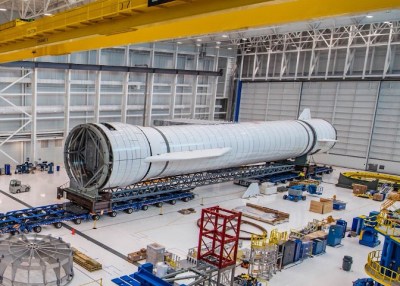
On November 8th, Blue Origin rolled out their GS1 simulator for the New Glenn’s first stage. This stand-in for the real rocket will never fly, but it’s designed to perfectly recreate the dimensions, center of gravity, and mass, of the real thing. Ground teams will use the GS1 to practice safely transporting the booster, which is approximately half the length of the Saturn V, from their production facility to Launch Complex 36 (LC-36) at Cape Canaveral. It will also be used to test the fit and function of various pieces of ground support equipment, and eventually, the second stage stacking procedure.
For the uninitiated, it might seem like this is a lot of fuss over what’s ultimately just a hollow metal tube. But the introduction of a test article such as this has traditionally been a major milestone during the design and construction of rockets and spacecraft, dating back to the “boilerplate” test capsules used during the Mercury, Gemini, and Apollo programs; a sure sign that what was just an idea is now becoming a reality.
Practice Makes Perfect

As anyone who’s worked on a project with many moving parts knows, sketches on paper or CAD models on the screen will only get you so far. Eventually you’ve got to commit your design, or at least some subset of it, to physical hardware to make sure your components fit and interact in the way you expect. This concept is even more critical when talking about something as monstrously complex as an orbital booster or human-rated spacecraft.
NASA created many test capsules in the early days of their manned space program, which ranged in complexity from inert mass simulators to instrument-laden craft that were actually launched into orbit to collect data on vehicle performance or the space environment. After all, in those early days, there were far more questions than answers. Without the luxury of modern simulation technology, building and flying a dummy capsule was the only real option.
By some accounts, there were at least 50 test capsules constructed for the Apollo program alone. Many of these bore little resemblance to the final Command Module that took the astronauts to the Moon, but that wasn’t always the point. Conversely, some were so accurate internally that they were used for astronaut training. While a large number of these capsules have survived into the present day, and can be found in museums all over the United States, several were either destroyed or otherwise lost during testing. Some ended up being cut up for scrap, or rebuilt and reused for another experiment.
Some Assembly Required
By the time the Space Shuttle development program was in full swing, the state-of-the-art had improved considerably. NASA was far more confident in their ability to simulate the behavior of the vehicle, to the point that there was famously no test flight of the complete Shuttle “stack” before John Young and Robert Crippen rode Columbia to space on April 12th, 1981.
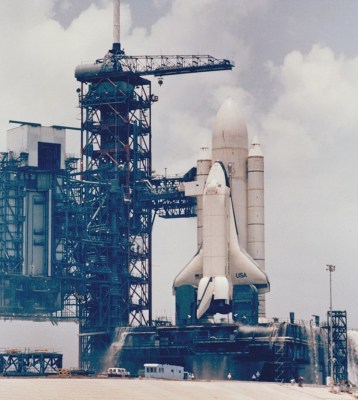
But that’s not to say they didn’t have some help leading up to the first crewed launch. NASA ran an extensive series of Approach and Landing Tests (ALTs) using the Enterprise, a prototype orbiter that was originally intended to be retrofitted for spaceflight until it was determined that it would actually be cheaper to build Challenger from scratch due to changes in the final vehicle design.
These flight tests, which saw the Enterprise dropped from the iconic Boeing 747 Shuttle Carrier Aircraft (SCA), were designed to characterize how the orbiter would handle while gliding back down to Earth after reentering the atmosphere. When the ALT program was complete, Enterprise went on tour to several NASA facilities for further testing.
It underwent vibratory tests at Marshall Space Flight Center, and later traveled to Kennedy Space Center so it could be used to verify stacking procedures in the Vehicle Assembly Building. Eventually, it even made its way to the launchpad at LC-39 where it was mated to dummy versions of the External Tank and Solid Rocket Boosters (SRBs) for fit checks with the Shuttle’s extensive Ground Support Equipment (GSE).
Though Enterprise is certainly the most well-known “dummy” Space Shuttle, it’s not the only one. NASA also produced Pathfinder, a test article not unlike Blue Origin’s GS1. Made partially out of wood, this inert stand-in for the orbiter was used for less critical training and testing applications.
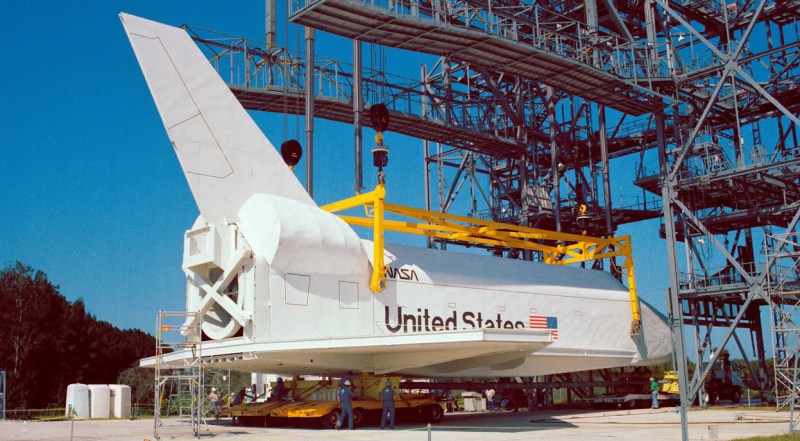
One Small Step, No Giant Leap
Clearly, Blue Origin’s GS1 is in good company as far as the history of American spaceflight is concerned, and it’s an excellent sign that the company is making progress with their long-delayed rocket. But while the company would undoubtedly like the press to see this public display of a completed test article as evidence that New Glenn is nearing operational status, the reality is less exciting.
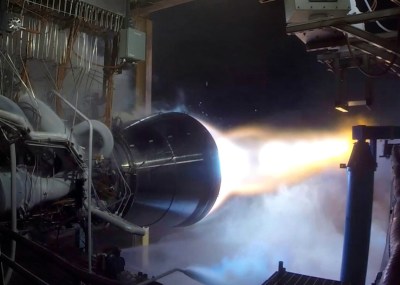
Even if Blue Origin has already built a flight-ready New Glenn, of which there is currently no evidence, the company has yet to complete work on the BE-4 engines that would power the heavy-lift vehicle. These are the very same engines that United Launch Alliance has been waiting on to install into their prototype Vulcan rocket. With two flagship launch vehicles literally unable to get off the ground until the BE-4 is operational, there’s enormous pressure on Blue Origin to deliver an engine that’s already at least four years behind schedule.
The lack of main engines is bad enough, but there’s also uncertainty surrounding the second stage of the New Glenn vehicle. The original plan was for the upper stage of the rocket to be expendable, with only the first stage landing on an ocean-going platform for refurbishment and eventual reflight; closely following the reuse program of the SpaceX Falcon 9 rocket. But over the summer it was revealed that Blue Origin intended to design a reusable second stage in an effort to lower operational costs and bring their capabilities better in line with SpaceX’s Starship. With so many missing pieces this late in the game, it seems likely that even in the best case scenario, New Glenn is still several years away from entering operational status.

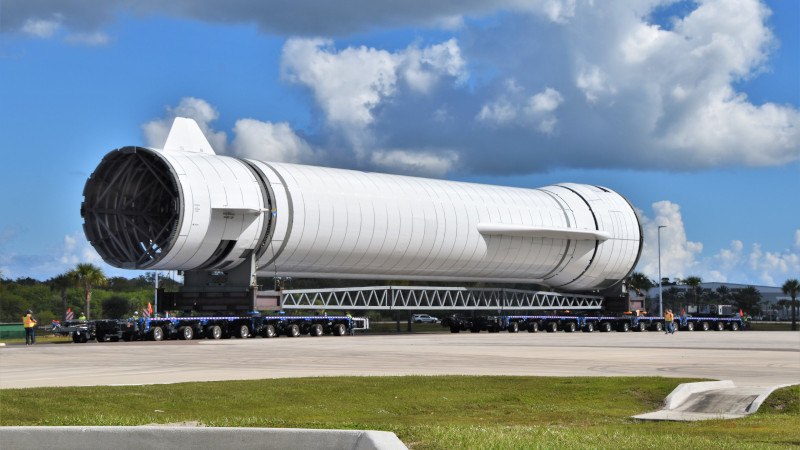













Mandatory meme https://i.redd.it/gu9p7m7hqyd71.jpg
False promises have been made I guess.
IIRC, during the Gemini program heyday, Kellogg’s Corn Flakes had a sweepstakes (printed on the back of the cereal box) to win a Gemini capsule mockup. I was jealous for the kid that was going to win it, but I bet his/her parents weren’t excited about having such a large item delivered to their apartment!
I remember being also being really excited about that contest to win the Gemini capsule, that is until I read the fine print in their ad. I believe that the winner could only pick which public museum you could donate it to – unfortunately you couldn’t keep it in your garage and play make believe astronaut in it forever.
I hope you got to sit in it at least once!
Hmmm, as a grade schooler, I didn’t bother to read the fine print!
(Sometimes as an adult, I still want to overlook the fine print.)
Thanks!
I’m sure I was wondering how many 4th of July skyrockets would be needed to make it to orbit!
B^)
I should have DAGS:
http://aviationintel.com/fast-history-the-boy-that-won-a-gemini-capsule/
https://www.cbr.com/gemini-capsule-model-comic-book-contest/
Wow, they used the “Flying Guppy” to deliver it. The grand prize winner also received a guitar of the type The Beatles played, and every Revell model kit. In those days, those kits may have taken up more room than the Gemini capsule.
“Because it had to be shipped via railroad direct to the donation site. ”
What about the “Flying Guppy” delivery promise in the ad?
Some time in the 1980’s I visited the visitor’s museum at Goddard Space Flight Center and got to sit in a some what beat-up mock-up of the Gemini capsule that they had placed outside. I haven’t been back in a couple of decades, but judging from pictures on the web, they have brought the mock-up inside, fixed it up a bit and still let you sit inside it.
Obligatory reference: “Have space suit, will travel”, by Robert A. Heinlein about a boy who wins a space suit in a similar vain.
Would be great if Blue Origin could try to do something that Spacex has not done before.
Blue Origin’s rockets are just carnival rides. Not even orbit, let alone taking humans to orbit and the ISS and back.
Bezos is not in the same league as SpaceX at all.
I really want to support and cheer Blue Origin, but with Bezos at the helm, amazon’s crappy behavior, Mr B’s thanks for making me rich speech, and the “if you can’t compete, litigate” moon contract approach, I mostly end up just feeling contempt for Blue Origin.
Which makes Elon look good???
B^)
So, Jeff gets all choked up and teary about saving the planet. Thinks Joe and Jane Doe should drive less, in a smaller car, not fly away on holiday, do it for the planet, man.
But he can have a dick-waving competition with Branson and Musk over rockets? There is a word for people like that.
Dick waving? Why do you bring Musk and by extension SpaceX into this?
SpaceX is extremely sucessful transportation company providing by many metrics cheapest transport to many orbits not only for government agencies and big companies around the whole world but also for small companies and universities which can’t afford to go with ULA or Arianespace etc..
Branson’s Virgin Galactic and Besos’s Sue Origin does NOT have a capability to lift a single gram to a lowest possible orbit at all period. Their playthings are on an almost whole order of magnitude lower energy level than what is required to achieve at least one orbit.
Branson at least have the Virgin Orbit but that’s completly different company than Virgin Galctic – jollyrider provider.
Like the cat in the box, the human race seems to be living simultaneously in 2 entirely incompatible states. In one we can all happily joyride into Space on a sea of rocket fuel, while in the other we have around 50 years left before the planet becomes uninhabitable. “Interesting” times!
One hundred of these joyrides into space, complemented with one hundred StarShip launches will pollute less than one cargo ship crammed with inconsequential crap gadgets from China.
Ah! When we should be sending cargo ships into space!
Either way it’s got Bezo’s sticky mitts all over it
I just realized what Bezos really wants to do: transport crap gadgets directly from China to consumers with intercontinental ballistic missiles.
Port congestion be damned, he’s gonna parachute Prime packages right to our doorsteps.
until you consider the fact that this bull shit is polluting our economy. wtf we wont put money into nasa but we get excited over billionairs accomplishing nil is beyond me. we pay for it all, nasa inventions become public domain for the good of all, private patents, not so much.
I’m not sure what SpaceX’s patent portfolio looks like. Publicly they seem to welcome anyone trying to do what they do. Falcon 9 uses a simple engine design, common fuels, nothing really exotic. The mojo is in the constant iteration and risk embracing culture.
Starship might not be “open source” but it’s about as out in the open as any major aerospace project ever has been.
“it seems we’re finally making the confident strides necessary to truly utilize space’s vast resources”
Which resources?
Not sure having more and more rockets fired up is gonna help with our carbon footprint.
I assume that’s around the issue of mining in space. Whether that’s mining on the moon or in the asteroids.
“Which resources?”
Satellite parking spots/orbits!
Build it and they will come they say … See what Bezos comes up with.